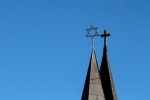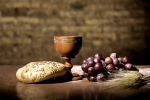July 15, 2020
Audra Abt Shares Five Resources on Multi-Cultural Congregations

Every month ECFVP offers five resources on a theme. This month we've asked the Rev. Audra Abt, who serves in Greensboro, North Carolina as the Vicar at Church of the Holy Spirit and Mission Developer for Abundant Life Health & Healing, to choose five resources that resonated with her. Please share this email with new members of your vestry and extend an invitation to subscribe to ECF Vital Practices to receive Vestry Papers and this monthly digest.
While the idea of building more diverse ministries and congregations tends to be met with approval, I also often hear from folks that it’s “too hard” or “confusing” and they don’t know where to begin. I usually start by responding that “yes!”, in my experience, it is difficult, and confusing, and disorienting. It is also joyful, liberating, and delicious.
Right now I get to serve as priest and mission developer for a couple of multicultural and multi-lingual missional communities, where we’re endeavoring (with God’s help) to become community where people know they’re valued (not just tolerated) no matter their age, churchiness, class upbringing, literacy, race, preferred language, sexual orientation, gender, comfort with or access to technology, etc, and where each person knows they have something the church needs in order to be alive as the Body of Christ.
As my colleague and friend the Rev. Sam Dessordi Peres Leite wrote in last month’s digest on Multicultural Congregations, “The first half of 2020 has become a season for new opportunities, to reimagine church life and its mission in new ways.” I agree, and I want to share these five Vital Practices articles that have been helpful for me in my ministry. Each offers some disciplines for living into more diverse and Beloved Community.
 With so much uncertainty about finances and what our worship and mission will look like, given the pandemic, it may seem counterintuitive to look to what small or shoe-string missions are doing. Turning to the most vulnerable congregants of more resourced congregations likewise may seem unusual. But it’s folks who’ve lived on the margins of respectable church and the ‘formal’ economy who have strategies for thriving and adapting to precarious and brutal circumstances. The Rev. Nancy Frausto in Sustainability in the Scrappy Church talks about the gifts of congregations who look to people - both in and outside the church - as resources, not just as charity cases. Because of their unique knowledge of what it takes to survive in a racist and exploitative world, they can lead the way to greater forms of flourishing even in the face of scarcity.
With so much uncertainty about finances and what our worship and mission will look like, given the pandemic, it may seem counterintuitive to look to what small or shoe-string missions are doing. Turning to the most vulnerable congregants of more resourced congregations likewise may seem unusual. But it’s folks who’ve lived on the margins of respectable church and the ‘formal’ economy who have strategies for thriving and adapting to precarious and brutal circumstances. The Rev. Nancy Frausto in Sustainability in the Scrappy Church talks about the gifts of congregations who look to people - both in and outside the church - as resources, not just as charity cases. Because of their unique knowledge of what it takes to survive in a racist and exploitative world, they can lead the way to greater forms of flourishing even in the face of scarcity.
 I’ve been humbled, and grateful, to have people with intellectual and physical disabilities show me my own presumptions about planning liturgy and other church activities that unintentionally left no room for them to participate and lead. Sarah Barton’s article, Welcoming Adults with Intellectual and Developmental Disabilities, invites the church to see each person as a resource. Barton recommends not just listening to our members but going out into the community to meet people where they are, listen, and allow what we hear to help us re-design the way we do everything. As we do this in my community, we’re finding that everyone is experiencing more access to deeper participation in our worship and service life.
I’ve been humbled, and grateful, to have people with intellectual and physical disabilities show me my own presumptions about planning liturgy and other church activities that unintentionally left no room for them to participate and lead. Sarah Barton’s article, Welcoming Adults with Intellectual and Developmental Disabilities, invites the church to see each person as a resource. Barton recommends not just listening to our members but going out into the community to meet people where they are, listen, and allow what we hear to help us re-design the way we do everything. As we do this in my community, we’re finding that everyone is experiencing more access to deeper participation in our worship and service life.
 Even in a multicultural congregation, there’s still a dominant norm for decision-making processes, leadership selection, and who speaks when. Often this norm fits the White, middle-class, professional culture. For people that don’t fit easily into your congregation’s norms, especially when they come from historically disenfranchised positions, it can be almost impossible to offer their gifts. As the Rev. Anna Olson writes about in Building a Diverse Vestry, developing a team that reflects the diversity of your congregation and surrounding community takes intentionality and a lot of work, but it is worth it.
Even in a multicultural congregation, there’s still a dominant norm for decision-making processes, leadership selection, and who speaks when. Often this norm fits the White, middle-class, professional culture. For people that don’t fit easily into your congregation’s norms, especially when they come from historically disenfranchised positions, it can be almost impossible to offer their gifts. As the Rev. Anna Olson writes about in Building a Diverse Vestry, developing a team that reflects the diversity of your congregation and surrounding community takes intentionality and a lot of work, but it is worth it.
 As startlingly beautiful as multicultural and multilingual life in Christ can be, I have also found it to be challenging because every encounter, every event also includes real opportunities for misunderstanding or offense, which can cause conflict. Valuing and raising up a multicultural community also means valuing change, letting Christ in to change the “we” we call the church. In Conflict and Change, Luisa Bonillas reminds us that conflict is normal, and we can all develop the capacity to endure the discomfort and move through conflict together.
As startlingly beautiful as multicultural and multilingual life in Christ can be, I have also found it to be challenging because every encounter, every event also includes real opportunities for misunderstanding or offense, which can cause conflict. Valuing and raising up a multicultural community also means valuing change, letting Christ in to change the “we” we call the church. In Conflict and Change, Luisa Bonillas reminds us that conflict is normal, and we can all develop the capacity to endure the discomfort and move through conflict together.
 The last discipline that I’ve found helpful in developing multicultural church community has been to stay eager and curious to know how Jesus is alive and present outside our membership. By seeking Christ and traces of the Holy Spirit working among others, we stay humble and tuned to God, who is bigger than any of us and any one culture. A Practical Theology of Episcopal Evangelism is a clear, succinct invitation to practice seeking, naming and celebrating how God is working new life and liberation among our neighbors right now, right where we are planted.
The last discipline that I’ve found helpful in developing multicultural church community has been to stay eager and curious to know how Jesus is alive and present outside our membership. By seeking Christ and traces of the Holy Spirit working among others, we stay humble and tuned to God, who is bigger than any of us and any one culture. A Practical Theology of Episcopal Evangelism is a clear, succinct invitation to practice seeking, naming and celebrating how God is working new life and liberation among our neighbors right now, right where we are planted.
The Rev. Audra Abt serves in Greensboro, North Carolina as the Vicar at Church of the Holy Spirit and Mission Developer for Abundant Life Health & Healing, a new Episcopal community and collaborative ministry of the Episcopal Diocese of North Carolina. Both of these communities are multi-lingual and intercultural expressions of their neighborhoods, with members from Latin America, West Africa, the Caribbean, and from around the U.S. She became an ECF Fellow in 2015 while developing a bilingual base community in Greensboro among Central American and U.S.-born neighbors. These leaders are helping Holy Spirit and Abundant Life envision a model of basic Christian community that can thrive and bear witness to God’s powerful presence in the world, even during this pandemic.





